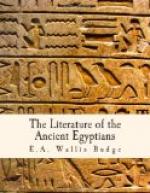[Footnote 3: The chief goddess of Sais, the city of Tafnekht.]
CHAPTER IX
AUTOBIOGRAPHICAL LITERATURE
Attention has already been called to the very great importance of the autobiographies of the military and administrative officials of the Pharaohs, and a selection of them must now be given. They are, in many cases, the only sources of information which we possess about certain wars and about the social conditions of the periods during which they were composed, and they often describe events about which official Egyptian history is altogether silent. Most of these autobiographies are found cut upon the walls of tombs, and, though according to modern notions their writers may seem to have been very conceited, and their language exaggerated and bombastic, the inscriptions bear throughout the impress of truth, and the facts recorded in them have therefore especial value. The narratives are usually simple and clear, and as long as they deal with matters of fact they are easily understood, but when the writers describe their own personal characters and their moral excellences their meaning is sometimes not plain. Such autobiographies are sometimes very useful in settling the chronology of a doubtful period of history, and as an example of such may be quoted the autobiography of Ptah-shepses, preserved in the British Museum. This distinguished man was born in the reign of Menkaura, the builder of the Third Pyramid at Gizah, and he was educated with the king’s children, being a great favourite of the king himself. The next king, Shepseskaf, gave him to wife Maatkha, his eldest daughter, in order to keep him about the Court. Under the succeeding kings Userkaf and Sahura he was advanced to great honour, and he became so great a favourite of the next king, Neferari-kara, that he was allowed to kiss the king’s foot instead of the ground on which it rested when he did homage. He was promoted to further honours by the next king, Neferefra, and he lived to see Userenra ascend the throne. Thus Ptah-shepses lived under eight kings, and his inscription makes it possible to arrange their reigns in correct chronological order.
THE AUTOBIOGRAPHY OF UNA
This inscription was found cut in hieroglyphs upon a slab of limestone fixed in Una’s tomb at Abydos; it is now in the Egyptian Museum in Cairo. It reads:
The Duke, the Governor of the South, the judge belonging to Nekhen, prince of Nekheb, the smer uat vassal of Osiris Khenti Amenti, Una, saith: “I was a child girded with a girdle under the Majesty of King Teta. My rank was that of overseer of tillage (?), and I was deputy inspector of the estates of Pharaoh.... I was chief of the teb chamber under the Majesty of Pepi. His Majesty gave me the rank of smer and deputy priest of his pyramid—town. Whilst I held the rank of ... His Majesty made me a ‘judge belonging to Nekhen.’




